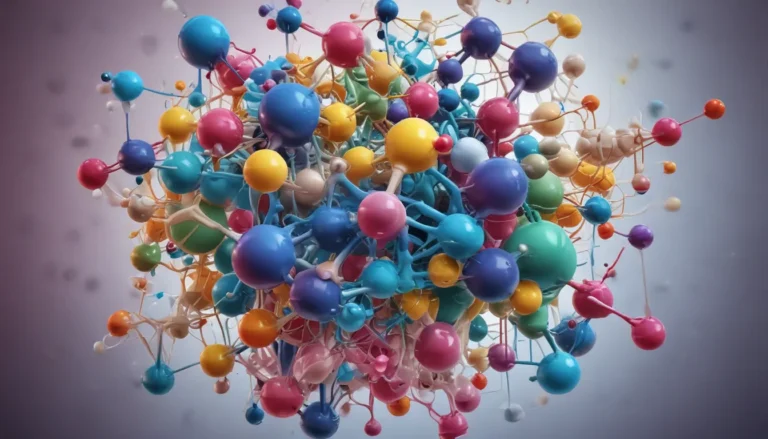A Note About Images: The images used in our articles are for illustration purposes only and may not exactly match the content. They are meant to engage readers, but the text should be relied upon for accurate information.
Chemistry enthusiasts, buckle up for a thrilling journey into the captivating realm of solubility! Whether you’re a student eager to explore the wonders of chemistry or a curious mind seeking to unravel the mysteries of dissolving substances, this article is brimming with enlightening insights that will leave you in awe. From the magical properties of water to the delicate dance of saturation and supersaturation, solubility is a fundamental concept that shapes countless chemical processes. So, let’s dive deep into the enchanting world of solubility and uncover 16 astonishing facts that will broaden your understanding and spark your curiosity.
Discovering the Intricacies of Solubility
Solubility is a mesmerizing concept in chemistry that delves into the ability of substances to dissolve in specific solvents. Whether it’s witnessing sugar dissolve in a steaming cup of tea or conducting experiments in the laboratory to explore complex compound solubility, understanding the dynamics of solubility is essential in various domains of chemistry. In this article, we will unearth fascinating facts about solubility that shed light on its significance and its profound impact on chemical reactions. So, gear up for an enlightening exploration of the captivating world of solubility!
The Enigmatic Nature of Water: The Universal Solvent
Water, often hailed as the universal solvent, possesses a remarkable ability to dissolve a diverse array of substances owing to its polarity and unique molecular structure. This exceptional quality of water plays a pivotal role in countless chemical reactions and biological processes, making it an invaluable solvent in various scientific disciplines.
Unraveling the Influence of Temperature
The solubility of most solids in liquids experiences a surge with increasing temperature, while the solubility of gases tends to decrease as the temperature rises. This temperature-dependent behavior of solutes in solvents is a critical aspect of solubility that underpins numerous physical and chemical phenomena.
Navigating Saturated Solutions: A Fine Equilibrium
A saturated solution represents a delicate balance wherein no more solute can be dissolved at a specified temperature. This state of equilibrium between dissolution and precipitation is a fundamental concept in solubility that highlights the dynamic interplay between solutes and solvents.
Embracing Supersaturation: A Riveting Anomaly
Supersaturation is a mesmerizing phenomenon characterized by a solution containing more solute than theoretically possible at a given temperature. This unstable state can lead to the formation of crystals, offering a glimpse into the intriguing complexities of solubility.
Embracing Polarity’s Influence
The interaction between solvents and solutes is intricately linked to their polarity, with polar solvents dissolving polar solutes and nonpolar solvents interacting with nonpolar solutes. The cardinal rule of “like dissolves like” encapsulates this fundamental principle of solubility.
Delving into the Solubility of Gases in Liquids
Henry’s Law elucidates the correlation between a gas’s pressure and its solubility in a liquid. According to this law, the solubility of a gas is directly proportional to its partial pressure, unveiling the intricate dynamics of gas-liquid interactions.
Unveiling the Mysteries of Salting Out and Salting In
The phenomena of salting out and salting in illuminate how the addition of electrolytes can either decrease or increase the solubility of a solute in a solution. These intriguing processes showcase the profound impact of external factors on solubility dynamics.
Embarking on the Journey of Precipitation
Precipitation heralds the transformation of a dissolved substance into a solid form within a solution, often culminating in the formation of crystals or a solid precipitate. This captivating process underscores the transition from solubility to solidity, unveiling the wonders of chemical transformations.
Exploring the Interplay Between pH and Solubility
The pH of a solution exerts a notable influence on the solubility of various substances, with acidic conditions enhancing the solubility of certain metal hydroxides. This intricate relationship between pH levels and solubility underscores the multifaceted nature of chemical interactions.
Immersing in Colligative Properties
Solubility’s role in colligative properties like boiling point elevation and freezing point depression showcases how these phenomena rely on the concentration of solute particles rather than the nature of the solute itself. This nuanced interconnection unveils the underlying principles governing solubility dynamics.
Unraveling the Impact of Pressure
Pressure serves as a key determinant of gas solubility in liquids, with the solubility of a gas being directly proportional to the pressure exerted on it, as elucidated by Henry’s Law. This interplay between pressure and solubility highlights the intricate balance that governs gas-liquid interactions.
Decoding the Behavior of Gaseous Oxygen in Water
Oxygen’s limited solubility in water can be influenced by factors such as temperature and pressure, with low temperatures and high pressures enhancing its solubility. This intriguing phenomenon sheds light on the dynamic interplay between gases and liquids in solubility dynamics.
Unveiling the Charms of Carbon Dioxide
Carbon dioxide’s high solubility in water underscores its pivotal role in the acidity of carbonated beverages and the generation of effervescent bubbles. This captivating attribute of carbon dioxide unveils its profound impact on solubility phenomena in aqueous solutions.
Navigating the Polar-Nonpolar Conundrum
The solubility of organic compounds hinges on their functional groups and the nature of the solvent, with polar solvents favoring polar compounds and nonpolar solvents accommodating nonpolar compounds. This dichotomy between polar and nonpolar interactions illuminates the diverse solubility behaviors observed in different chemical systems.
Embarking on the Journey of Crystallization
Crystallization signifies the transition from a homogeneous solution to a crystalline solid, culminating in the formation of well-defined crystals with distinct properties. This captivating process underscores the transformative nature of solubility dynamics, leading to the emergence of unique crystalline structures.
Embracing Solubility’s Environmental Implications
The solubility of pollutants in water plays a pivotal role in determining their environmental impact and fate. Understanding the solubility of contaminants is vital for assessing their implications and devising effective remediation strategies, underscoring the critical role of solubility in environmental science.
In conclusion, the realm of solubility is a mesmerizing domain that holds a wealth of intriguing revelations and profound implications for diverse scientific disciplines. From its influence on colligative properties to its role in environmental remediation, solubility pervades countless facets of chemistry, offering a rich tapestry of knowledge for exploration. By delving into the intricate nuances of solubility, scientists and researchers can unlock groundbreaking insights and pave the way for innovative discoveries that shape our understanding of the chemical world. So, next time you witness a substance dissolving in a solution or crystals forming in a supersaturated state, take a moment to appreciate the astounding nature of solubility and the myriad wonders it unveils in the realm of chemistry.
FAQs
-
What is solubility?
Solubility refers to the ability of a substance, known as the solute, to dissolve in another substance, known as the solvent, forming a homogeneous mixture called a solution. -
How is solubility measured?
Solubility is typically measured as the maximum amount of solute that can dissolve in a specific amount of solvent at a given temperature and pressure, often expressed in grams of solute per liter of solvent. -
What factors influence solubility?
Several factors can impact solubility, including temperature, pressure, the nature of the solute and solvent, and the presence of other substances in the solution. -
Why does solubility change with temperature?
In most cases, solubility increases with rising temperatures, as higher temperatures provide the energy needed for solute particles to overcome attractive forces and disperse more easily in the solvent. -
Can pressure affect solubility?
Yes, pressure can influence solubility, particularly in cases involving gases as solutes. Increasing pressure can enhance gas solubility in a liquid, whereas reducing pressure can reduce gas solubility. -
What is solvation?
Solvation entails solvent molecules surrounding and interacting with solute particles to stabilize them in a solution. It involves breaking solute-solute and solvent-solvent interactions and forming solute-solvent interactions. -
What is supersaturation?
Supersaturation occurs when a solution holds more dissolved solute than it can typically accommodate at a given temperature, resulting in a metastable state with the potential for crystal formation.
Solubility’s enchanting allure extends far beyond these 16 facts, offering a vast landscape of exploration and discovery. Venture further into the captivating world of solubility by delving into the intriguing aspects of solubility product constants, solubility product constants Ksp, and the profound influence of the common ion effect on solubility. Each topic unveils unique perspectives on solubility’s intricate behavior, providing a comprehensive understanding of this essential chemical phenomenon. Embark on an illuminating odyssey through the multifaceted realm of solubility, where each revelation enhances your appreciation for the dissolving world that surrounds us.
Your Feedback Matters
Your trust and engagement are the cornerstones of our commitment to delivering credible and captivating content. Every fact shared on our platform is a product of user contributions, enriching our database with a diverse array of insights and information. Our dedicated editors painstakingly review each submission to ensure the highest standards of accuracy and reliability, guaranteeing that the facts we present are not only fascinating but also authentic. Explore and learn with confidence, knowing that our dedication to quality and authenticity underpins every facet of your journey with us.






